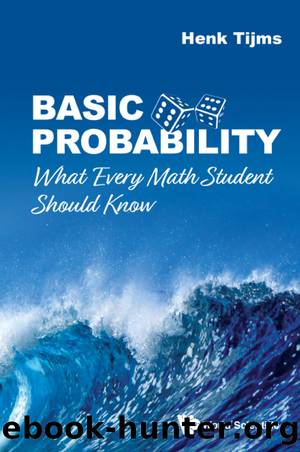Basic Probability by Henk Tijms

Author:Henk Tijms
Language: eng
Format: epub
Publisher: World Scientific Publishing Company
Published: 2019-12-15T00:00:00+00:00
Table 1: Binomial and Poisson probabilities
Example 3.2. There are 500 people present at a gathering. For the fun of it, the organizers have decided that all of those whose birthday is that day will receive a present. How many presents should the organization procure in order to ensure a less than 1% probability of having too few presents?
Solution. Let the random variable X represent the number of individuals with a birthday on the day of the gathering. Leap year day, February 29, is discounted, and apart from that, it is assumed that every day of the year is equally likely as birthday. The distribution of X can then be modeled by a binomial distribution with parameters n = 500 and p = . Calculations reveal that k = 5 suffices in order to have P(X > k) < 0.01. For k = 5, P(X > k) = 0.0029 and so five presents suffice. In this example, n is large and p is small such that the binomial distribution of X can be nicely approximated by a Poisson distribution with expected value λ = np = . For comparison, both for the binomial distribution and the Poisson distribution, Table 1 gives the probability that exactly k persons have a birthday on the day of the gathering for k = 0, 1, . . . , 6.
Problem 3.1. A fair coin is to be tossed six times You win two dollars if heads appears exactly three times (the expected number) and you lose one dollar otherwise. Is this game advantageous to you? (answer: no, your win probability is )
Problem 3.2. Daily Airlines flies from Amsterdam to London every day. The price of a ticket for this extremely popular flight route is $75. The aircraft has a passenger capacity of 150. The airline management has made it a policy to sell 157 tickets for this flight in order to protect themselves against no-show passengers. Experience has shown that the probability of a passenger being a no-show is equal to 0.08. The booked passengers act independently of each other. Specify the probability distribution of the number of no-shows on a flight. What is the probability that some passengers will have to be bumped from the flight? (answer: 0.0285)
Problem 3.3. Chuck-a-Luck is a carnival game of chance and is played with three dice. To play this game, the player chooses one number from the numbers 1, . . . , 6. The three dice are then rolled. If the playerâs number does not come up at all, the player loses 10 dollars. If the chosen number comes up one, two, or three times, the player wins $10, $20, or $30 respectively. What are the expected value and the standard deviation of the win for the house per wager? (answer: $0.787 and $11.13)
Problem 3.4. In a game called â26â, a player chooses one number from the numbers 1, 2, . . . , 6 as point number. After this, the player rolls a collection of ten dice thirteen times in succession.
Download
This site does not store any files on its server. We only index and link to content provided by other sites. Please contact the content providers to delete copyright contents if any and email us, we'll remove relevant links or contents immediately.
Management Strategies for the Cloud Revolution: How Cloud Computing Is Transforming Business and Why You Can't Afford to Be Left Behind by Charles Babcock(4127)
Ego Is the Enemy by Ryan Holiday(3982)
Offensive Shellcode from Scratch by Rishalin Pillay(3621)
Exploring Deepfakes by Bryan Lyon and Matt Tora(3183)
Robo-Advisor with Python by Aki Ranin(2958)
Learning C# by Developing Games with Unity 2021 by Harrison Ferrone(2839)
Speed Up Your Python with Rust by Maxwell Flitton(2832)
Liar's Poker by Michael Lewis(2806)
Linux Command Line and Shell Scripting Techniques by Vedran Dakic and Jasmin Redzepagic(2785)
Agile Security Operations by Hinne Hettema(2782)
OPNsense Beginner to Professional by Julio Cesar Bueno de Camargo(2780)
Extreme DAX by Michiel Rozema & Henk Vlootman(2777)
Essential Cryptography for JavaScript Developers by Alessandro Segala(2721)
Elevating React Web Development with Gatsby by Samuel Larsen-Disney(2710)
AI-Powered Commerce by Andy Pandharikar & Frederik Bussler(2628)
Python for ArcGIS Pro by Silas Toms Bill Parker(2623)
Cryptography Algorithms by Massimo Bertaccini(2615)
Incident Response Techniques for Ransomware Attacks by Oleg Skulkin(2609)
Distributed .NET with Microsoft Orleans by Bhupesh Guptha Muthiyalu Suneel Kumar Kunani(2609)
